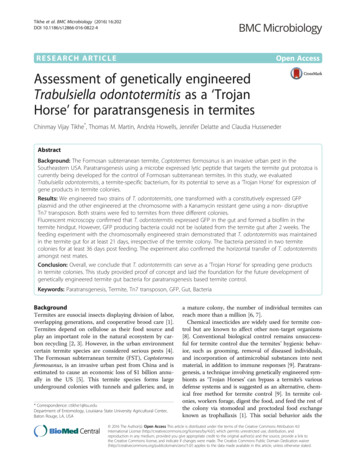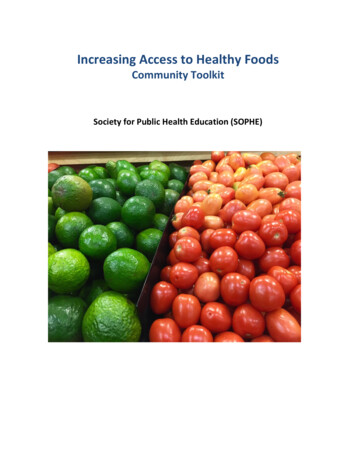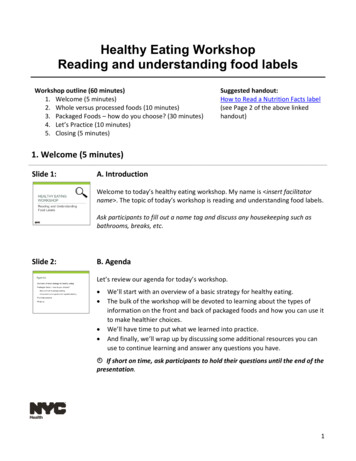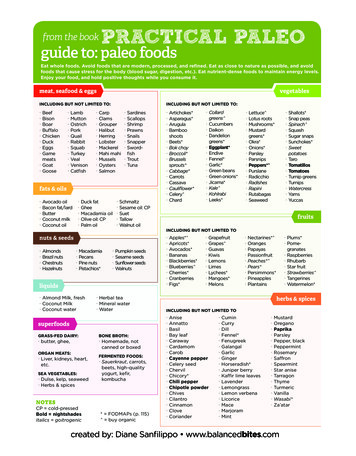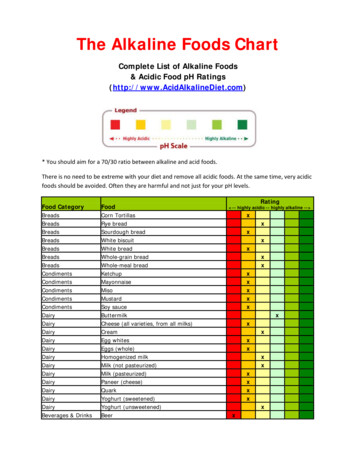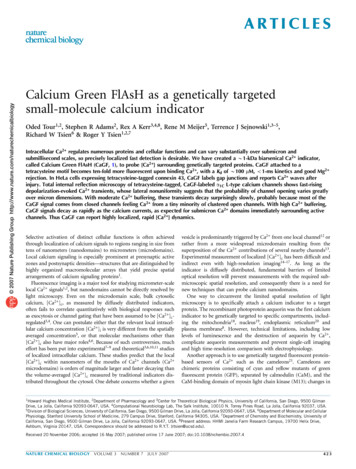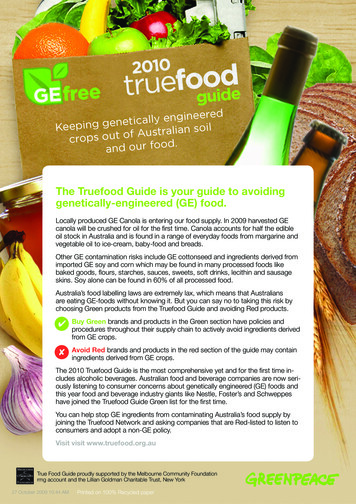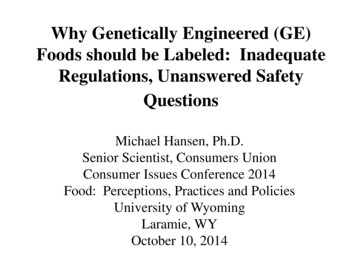
Transcription
Why Genetically Engineered (GE)Foods should be Labeled: InadequateRegulations, Unanswered SafetyQuestionsMichael Hansen, Ph.D.Senior Scientist, Consumers UnionConsumer Issues Conference 2014Food: Perceptions, Practices and PoliciesUniversity of WyomingLaramie, WYOctober 10, 2014
Outline Basics of BiotechnologyFDA global policy on GE, including labelingNew science raises safety questionsProfessional conflicts of interest bias outcomes infavor of finding no health or safety issues Summary
Biotechnology Basics
The basic structure and functions of genes and chromosomes
Plant transformation with Agrobacterium (Ti plasmid) and gene gun
FDA Policy on Genetically Engineered Plants1992 Statement of Policy Introduced at press conference at an industry gathering onMay 27, 1992 by then Vice-President Dan Quayle as aderegulatory initiative Based on notion “that the new techniques [e.g. geneticengineering] are extensions at the molecular level oftraditional methods and will be used to achieve the same goalsas traditional plant breeding” and “no basis for concluding thatbioengineered foods differ from other foods in any meaningfulor uniform way, or that, as a class, foods developed by the newtechniques present any different or greater safety concern thanfoods developed by traditional plant breeding.”(57 FR 22991,May 29, 1992)
FDA Policy on Genetically Engineered Plants1992 Statement of Policy No requirement for human safety testing, only “voluntarysafety consultations”; to date, some 99 voluntary safetyconsultations have been held “Ultimately, it is the food producer who is responsible forassuring safety” (57 FR 22991, May 29, 1992) “Monsanto should not have to vouchsafe the safety of biotechfood Our interest is in selling as much of it as possible.Assuring its safety is the FDA’s job” Phil Angel, Director ofCorporate Communications, Monsanto. New York TimesMagazine, October 25, 1998.
Key phrases in US Food and DrugAdministration safety consultation letters MON 810 (Bt corn), dated Sept. 26, 1996 “Monsanto submitted a summary assessment of corn containing transformationevent MON 810 on June 6, 1996” “Based on the safety and nutritional assessment you have conducted, it is ourunderstanding that Monsanto has concluded that corn products derived fromthis new variety are not materially different in composition, safety, and otherrelevant parameters from corn currently on the market, and that the geneticallymodified corn does not raise issues that would require premarket review orapproval by /Biotechnology/Submissions/ucm161107.htm A variation of these two sentences are found in all 97 safety consultation letters FDA does not require premarket safety assessment and does not state its ownopinion about the safety of the GE crop
Martineau, B. 2001. First Fruit: the Creation of the FlavrSavr tomato and the Birth of Biotech Foods “Rather than personal opinion, the scientific communityshould give the public facts, hard facts; the results ofstudies that indicate these foods are safe to eat . . . simplyproclaiming ‘that these foods are safe and there is noscientific evidence to the contrary’ is not the same assaying ‘extensive tests have been conducted and here arethe results.’ In fact, without further elaboration, ‘noscientific evidence to the contrary’ could be construed as‘no scientific evidence, period.’ ” (Martineau, 2001:232-233)
FDA. 2001. Premarket Notice Concerning Bioengineered Foods.Federal Register January 18, 2001. Vol. 51(12): pp. 4706 – ucm096149.htm "[B]ecause some rDNA-induced unintended changes arespecific to a transformational event (e.g. those resulting frominsertional mutagenesis), FDA believes that it needs to beprovided with information about foods from all separatetransformational events, even when the agency has beenprovided with information about foods from rDNA-modifiedplants with the same intended trait and has had no questionsabout such foods. In contrast, the agency does not believe thatit needs to receive information about foods from plants derivedthrough narrow crosses [e.g. traditional breeding]" italicsadded (FR 66(12), pg. 4711) FDA admits that there is a difference between GE andtraditional breeding, yet they still follow the 1992 policy
Codex Alimentarius Food safety standard setting organization of the UnitedNations. Joint World Health Organization (WHO) andFood and Agriculture Organization (FAO) Set up in 1960s to help developing countries with range ofvoluntary, standards, guidelines and recommendationsassociated with food safety 1995 Marrakech Agreement, General Agreement onTariffs and Trade (GATT) replaced by World TradeOrganization (WTO) Codex standards, guidelines and recommendationsconsidered “trade legal”
Codex Alimentarius Ad Hoc Intergovernmental Task Force on Foods Derived fromBiotechnology (2000 – 2003; 2005-2008) Hosted by Japan Developed 4 key documents: CAC/GL 44 Principles for Risk Analysis of Foods Derivedfrom Modern Biotechnology (2003) CAC/GL 45 Guideline for the Conduct of Food SafetyAssessment of Foods Derived from Modern Biotechnology(2003, 2008) CAC/GL 46 Guideline for the Conduct of Food SafetyAssessment of Foods Produced Using Recombinant-DNAMicroorganisms (2003) CAC/GL 68 Guideline for the Conduct of Food SafetyAssessment of Foods Derived from Recombinant-DNAAnimals (2008)
Codex Alimentarius: Principles for the Risk Analysis of FoodsDerived from Modern Biotechnology(CAC/GL 44—2003) “18. Risk managers should take into accountthe uncertainties in the risk assessment andimplement appropriate measures to managethese uncertainties. 19. Risk management measures may include,as appropriate, food labeling, conditions formarket approval and post-market monitoring.”(para 18, 19 CAC/GL 44—2003)
Codex Alimentarius Guideline for the Conduct of Food Safety Assessmentof Foods Derived from Recombinant-DNA Plants– “Unintended effects due to genetic modification may besubdivided into two groups: those that are “predictable”and those that are “unexpected” . . . A variety of data andinformation are necessary to assess unintended effectsbecause no individual test can detect all possibleunintended effects or identify, with certainty, those relevantto human health. These data and information whichconsidered in total, provide assurance that the food isunlikely to have an adverse effect on human health” italicsadded (paras 16 and 17, CAG/GL 45-2003)
Guideline for the Conduct of Food Safety Assessment of FoodsDerived from Modern Biotechnology (CAC/GL 45, 2003) Unintended effects “Unintended effects in recombinant-DNA plants may also arise throughthe insertion of DNA sequences and/or may arise through subsequentconventional breeding of the recombinant DNA plant” (para 14). [e.g.stacked traits] “Unintended effects can result from the random insertion of DNAsequences into the plant genome which may cause disruption or silencingof existing genes, activation of silent genes, or modifications in theexpression of existing genes. Molecular biological and biochemicaltechniques can also be used to analyse potential changes at the level ofgene transcription and message translation that could lead to unintendedeffects”. (paras 15, 16) [importance of –omics technologies, e.g.genomics, transcriptomics, proteomics, metabolomics, as well dsRNAprofiling which need to be validated and incorporated into regulatory riskassessments]
Codex Alimentarius Codex Committee on Food Labeling has worked on aguidance on labeling GE foods since 1995 “Codex Alimentarius Commission has stated thatgovernments are free to decide on whether and how tolabel foods derived from modern biotechnology, includingfoods containing genetically modified organisms. Thelabeling should be done in conformity with the textapproved by the Codex Commission, to avoid a potentialtrade barrier. The decision, which will help informconsumers’ choices regarding genetically-modifiedfoodstuffs, was taken at the 34th Session of theCommission, held in Geneva from 4-9 July 2011. Morethan 600 delegates from 145 of the 184 membercountries, UN, inter-governmental and non-governmentalorganizations attended”
UNINTENDED EFFECTS
Transformation—pleitropy, epistatis, unexpected effectsFrom Kuiper et al. 2001. Assessment of the food safety issues related togenetically modified foods. The Plant Journal, 27(6): 503-528
Zolla, L. et al. 2008. Proteomics as a Complementary Tool for IdentifyingUnintended Side Effects Occurring in Transgenic Maize Seeds As a Result ofGenetic Modifications. Journal of Proteome Research, 7: 1850-1861. Proteomics is the study of expressed proteins. This is goodway to detect unintended effects associated with GE,particularly the disruptive effects due to the random insertionof transgene Superior study design: GE maize (MON810) and near isolinegrown side-by-side in growth chamber, to control forenvironmental effects
Zolla, L. et al. 2008. Proteomics as a Complementary Tool for IdentifyingUnintended Side Effects Occurring in Transgenic Maize Seeds As a Result ofGenetic Modifications. Journal of Proteome Research, 7: 1850-1861. Results: “43 proteins resulted up- or down-regulated in transgenicseeds with respect to their controls (T06 vs WT06), which could bespecifically related to the insertion of a single gene into a maizegenome by particle bombardment.” (pg. 1850). Of these 43 proteins,14 were down-regulated, 13 up-regulated, 9 shut off and 7 newlyexpressed. “Interestingly, a newly expressed spot (SSP 6711) corresponding to50 kDa gamma zein, a well-known allergenic protein, has beendetected. Moreover, as a major concern, a number of seed storageproteins (such as globulins and vicilin-like embryo storage proteins)exhibited truncated forms having molecular masses significantlylower than the native ones.” (pg. 1855)
Animal Feeding Studies
Finamore, A et al. 2008. Intestinal and Peripheral Immune Response toMON810 Maize Ingestion in Weaning and Old Mice. Journal of Agriculturaland Food Chemistry Well designed study: MON810 and near isoline grown simultaneously inneighboring fields in Landriano, Italy, to control for environmental effects “This study evaluated the gut and peripheral immune response togenetically modified (GM) maize in mice in vulnerable conditions.Weaning and old mice were fed a diet containing MON810 or its parentalcontrol maize . . . for 30 and 90 days. . . As compared to control maize,MON810 maize induced alterations in the percentage of T and B cells andof CD4 , CD8 , T, and RT subpopulations of weaning and old mice fed for30 or 90 days, respectively, at the gut and peripheral sites. An increase ofserum IL-6, IL-13, IL-12p70, and MIP-1 [cytokines involved in allergenicand inflammatory response] after MON810 feeding was also found. Theseresults suggest the importance of the gut and peripheral immune responseto GM crop ingestion as well as the age of the consumer in the GMO safetyevaluation.”
Aris, A. and S. Leblanc. 2011. Maternal and fetal exposure to pesticidesassociated to genetically modified foods in Eastern Townships of Quebec,Canada. Reproductive Toxicology, doi:10.1016/j.reprotox.2011.02.004. Study involved 30 pregnant, 39 nonpregnant womenin Quebec, Canada. Blood taken from women and from fetal cord bloodand tested for 3 pesticides associated with GM:glyphosate, glufosinate, Cry1Ab Results: detected metabolite of glufosinate (3-MPPA)and Cry1Ab in maternal (93%), fetal (80%) andnonpregnant women’s blood (69%)
Aris, A. and S. Leblanc. 2011. Maternal and fetal exposure to pesticides associated togenetically modified foods in Eastern Townships of Quebec, Canada. ReproductiveToxicology, doi:10.1016/j.reprotox.2011.02.004.
Aris, A. and S. Leblanc. 2011. Maternal and fetal exposure to pesticidesassociated to genetically modified foods in Eastern Townships of Quebec,Canada. Reproductive Toxicology, doi:10.1016/j.reprotox.2011.02.004. Conclusion: “To our knowledge, this is the firststudy to highlight the presence of pesticidesassociated genetically modified foods in maternal,fetal and nonpregnant women’s blood. 3-MPPA andCry1Ab toxin are clearly detectable and appear tocross the placenta to the fetus. Given the potentialtoxicity of these environmental pollutants and thefragility of the fetus, more studies are needed,particularly those using the placental transferapproach.”
Séralini et al. 2011. Genetically modified crops safety assessments: presentlimits and possible improvements. Environmental Sciences Europe 2011,23:10 10.pdf
Séralini et al. 2011. Genetically modified crops safety assessments:present limits and possible improvements. Environmental Sciences Europe2011, 5-23-10.pdfConclusions: The 90-day-long tests are insufficient to evaluate chronictoxicity, and the signs highlighted in the kidneys and livers could be the onsetof chronic diseases. However, no minimal length for the tests is yet obligatoryfor any of the GMOs cultivated on a large scale, and this is sociallyunacceptable in terms of consumer health protection.
American Medical Association policy onbioengineered foods, passed at June, 2012 AMAmeeting. -e-grid.pdf (4) Our AMA supports mandatory pre-market systematic safetyassessments of bioengineered foods and encourages:(a) development and validation of additional techniques for the detectionand/or assessment of unintended effects;(b) continued use of methods to detect substantive changes in nutrient ortoxicant levels in bioengineered foods as part of a substantial equivalenceevaluation;(c) development and use of alternative transformation technologies to avoidutilization of antibiotic resistance markers that code for clinically relevantantibiotics, where feasible; and(d) that priority should be given to basic research in food allergenicity tosupport the development of improved methods for identifying potentialallergens. The FDA is urged to remain alert to new data on the healthconsequences of bioengineered foods and update its regulatory policiesaccordingly.
Summary US policy on GE plants inadequate– safety assessments not required, even though FDA admitsGE differs from conventional breeding– labeling not required Global agreement that GE is different than conventionalbreeding and that safety assessments should be required Unanswered health questions persist for GE plants and moreindependent tests are needed Labeling is needed to potentially detected any health impacts ofGMOs, e.g. to serve as a risk management measure to deal withscientific uncertainty.
FDA Policy on Genetically Engineered Plants 1992 Statement of Policy Introduced at press conference at an industry gathering on May 27, 1992 by then Vice-President Dan Quayle as a deregulatory initiative Based on notion "that the new techniques [e.g. genetic
